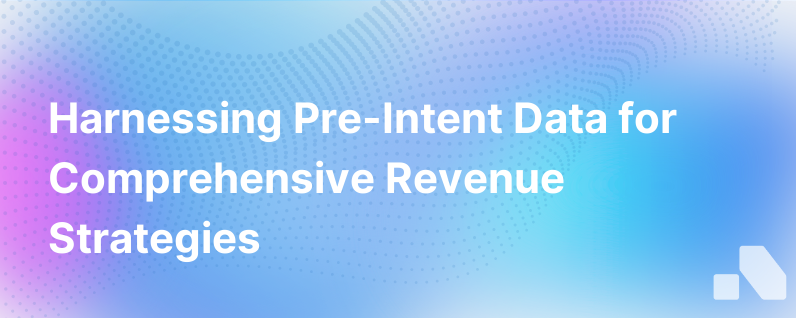
In the dynamic realm of sales and marketing, mastering the art of anticipation provides a competitive edge that distinguishes the top-performing companies from the rest. Enter pre-intent data — the crystal ball of the digital age that enables businesses to predict and engage potential customers even before they have articulated their intent to buy. This transformative addition to your arsenal complements and enhances your revenue strategy in manifold ways.
Presenting as a blend of behavioral analytics, market trends, and predictive modeling, pre-intent data is the subtle art of identifying prospective buyers based on their activities and engagements early on in their journey. It delves deep into the fabric of online behavior, gathering signals from a blend of structured and unstructured interactions. These might be users consuming related content, attending industry events, or engaging with topics online that align with your offerings.
The Significance of Pre-Intent Data in Modern Revenue Strategy
The traditional buyer's journey has seen an evolution. With the wealth of information available online, potential customers now often make up their minds long before they interact with a salesperson. By tapping into pre-intent data, companies can craft strategies that align with the customer's journey from its true inception — the nascent stage of ideation and research.
Understanding and leveraging pre-intent signals empowers businesses to strategically tailor their marketing efforts, account-based strategies, and sales pitches to specific needs and behaviors identified within their target demographic. Rather than waiting for prospects to come to them, businesses can proactively approach potential customers with solutions aligned to their evolving requirements, thus influencing decision-makers at a much earlier stage.
Here are several ways pre-intent data rounds out your revenue strategy:
-
Improved Lead Generation and Qualification: Pre-intent data offers a more sophisticated approach to generating and nurturing leads. By recognizing patterns in early-stage research and interest signals, lead generation efforts can be far more targeted, yielding a higher quality prospect pool.
-
Enhanced Account-Based Marketing (ABM): ABM thrives on precision. Pre-intent data provides the granular insights needed for hyper-personalization, allowing companies to engage key accounts with tailored messaging that speaks to anticipated needs.
-
Strategic Content Creation: Armed with insights from pre-intent data analyses, content marketers can craft resourceful, visionary content that addresses unspoken questions and needs, positioning your brand as a thought leader ready to guide them through impending challenges.
-
Optimized Buyer Journeys: With a better grasp on where a prospect stands in their journey, sales and marketing teams can fine-tune their timing and outreach strategies for maximum impact, avoiding the common pitfalls of premature hard sales tactics or late engagement.
-
Anticipatory Product Development and Enhancement: Product teams can use pre-intent signals to discern market shifts and evolving user needs, guiding innovation and feature development that addresses future market demands.
-
Increased Conversion Rates and Accelerated Sales Cycles: By identifying and addressing customer needs early, businesses can cultivate trust and brand loyalty sooner, thus streamlining the sales process and shortening sales cycles.
-
Competitive Differentiation: In crowded markets, becoming the first to identify and act on budding customer needs can set a brand apart, forging a narrative as a proactive, customer-centric organization.
-
Cost Efficiency and Resource Optimization: Focusing on prospects with demonstrated pre-intent activity increases ROI by directing resources toward the most promising engagements, decreasing waste on low-potential leads.
Integrating Pre-Intent Data into Your Revenue Strategy
To effectively incorporate pre-intent data into your revenue strategy, it's crucial to have the right technology and processes in place. Advanced tools like artificial intelligence and machine learning algorithms can mine vast swaths of data, extracting meaningful patterns and insights. Bridging the gap between data science and practical business application, solutions like Aomni streamline this integration, providing actionable insights through real-time account research and competitive intelligence within a navigable platform.
Here are practical steps to harness the potential of pre-intent data:
- Invest in technology: Deploy AI-powered platforms to aggregate and interpret pre-intent data.
- Harmonize your teams: Ensure marketing, sales, and product teams work in unison, fueled by shared data insights.
- Cultivate data literacy: Develop an organizational understanding of data interpretation to empower decision-making.
- Engage in predictive analytics: Use pre-intent signals to forecast trends and align your strategy to market ebbs and flows.
- Implement continuous learning: Consistently refine your approach as you gather more data and insights.
Conclusion
Pre-intent data's ability to anticipate needs and influence early stages of the buyer's journey cements it as an invaluable composite in the modern revenue strategy mosaic. Leveraging these insights ensures companies are not merely reacting to market demands but are predicting and shaping them. It's here where the true art of sales and marketing thrives, where data is not just retrospectively informative but prospectively transformative.
As businesses look towards an ever-evolving marketplace, pre-intent data offers a beacon – guiding them not just towards potential customers, but towards creating a dialogue that is founded on understanding and foresight. With AI tools like Aomni at your side, embarking on this journey of anticipatory engagement becomes seamless, allowing you to place the building blocks for sustained revenue growth.